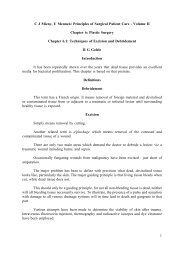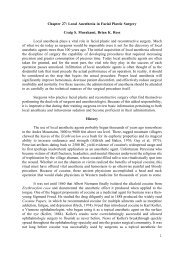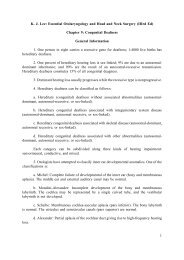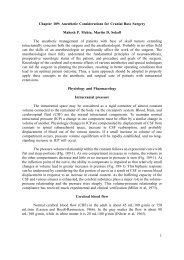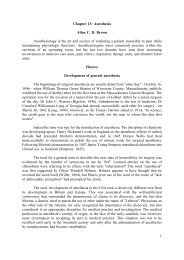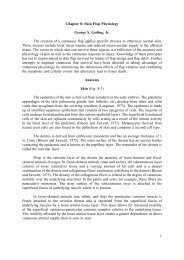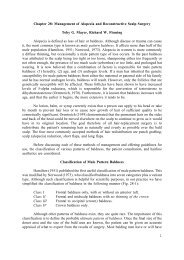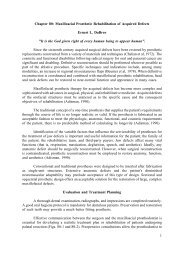1 Chapter 99: Congenital Disorders of the Larynx ... - Famona Site
1 Chapter 99: Congenital Disorders of the Larynx ... - Famona Site
1 Chapter 99: Congenital Disorders of the Larynx ... - Famona Site
Create successful ePaper yourself
Turn your PDF publications into a flip-book with our unique Google optimized e-Paper software.
Endoscopic findings. A lateral airway radiographic study usually shows <strong>the</strong> congenital<br />
subglottic stenosis clearly (Fig. <strong>99</strong>-21). However, <strong>the</strong> definitive diagnosis is made at<br />
endoscopy; <strong>the</strong> diameter <strong>of</strong> <strong>the</strong> subglottic region is assessed carefully and gently, especially<br />
if <strong>the</strong> airway is marginal. The usual finding is an isolated circumferential subglottic stenosis,<br />
<strong>the</strong> diameter <strong>of</strong> which is <strong>the</strong>n measured. The outside diameter <strong>of</strong> a bronchoscope or an<br />
endotracheal tube that passes comfortably through <strong>the</strong> subglottic region represents <strong>the</strong> internal<br />
diameter <strong>of</strong> <strong>the</strong> cricoid, which is <strong>the</strong>refore calibrated and recorded for future reference. The<br />
endoscopic findings are less severe than those in patients with acquired subglottic stenosis.<br />
Occasionally diagnostic endoscopy results in minimal but significant mucosal swelling<br />
in <strong>the</strong> subglottic region, caused by <strong>the</strong> trauma <strong>of</strong> excessive manipulation, <strong>the</strong> passage <strong>of</strong> too<br />
large a bronchoscope, or repeated manipulation. This is more significant when <strong>the</strong>re is a<br />
preexisting subglottic stenosis. Subglottic edema occurs within <strong>the</strong> limits <strong>of</strong> <strong>the</strong> inexpansible<br />
cricoid cartilage in <strong>the</strong> immediate postendoscopic period. There may be croupy cough, stridor,<br />
and increasing airway obstruction. Careful technique should reduce <strong>the</strong> incidence <strong>of</strong> this<br />
complication to an absolute minimum.<br />
Management<br />
Management is based on <strong>the</strong> knowledge that children outgrow congenital subglottic<br />
stenosis. Most cases produce few or minimal symptoms, and no definitive treatment is<br />
required unless acute inflammation or trauma from intubation or endoscopy precipitates<br />
serious obstruction. However, when a major degree <strong>of</strong> congenital subglottic stenosis exists or<br />
when acquired fibrous tissue granulations and edema produce a serious obstruction, a<br />
tracheotomy may be require. Small patients with a stenosis severe enough to require a<br />
tracheotomy may require repeated endoscopic examination over months or years, awaiting<br />
sufficient relative improvement <strong>of</strong> <strong>the</strong> subglottic diameter to allow decannulation. This<br />
conservative management prevents <strong>the</strong> potential complications <strong>of</strong> external laryngeal surgery<br />
in <strong>the</strong> infant. On <strong>the</strong> o<strong>the</strong>r hand, Cotton and Evans (1981), among o<strong>the</strong>rs, have advocated a<br />
more aggressive approach by laryngotracheal surgical reconstruction to obtain a lumen large<br />
enough to permid decannulation. Repeated "dilation treatment" <strong>of</strong> hard cartilaginous stenosis<br />
is not successful, and ill-judged forced "dilations" inevitably cause fur<strong>the</strong>r trauma and<br />
scarring. Laser resection has a limited application and must be restricted to treatment <strong>of</strong> <strong>the</strong><br />
s<strong>of</strong>t tissue swelling in selected cases where <strong>the</strong> stenosis is less than 5 mm thick. There is no<br />
uniform management <strong>of</strong> subglottic stenosis and no universally successful endoscopic or<br />
external surgical technique. The tracheotomy tube usually should be worn for an extended<br />
period <strong>of</strong> time to allow <strong>the</strong> cartilaginous stenosis to grow along with <strong>the</strong> child's general rate<br />
<strong>of</strong> growth until <strong>the</strong> problem is overcome. Decannulation is usually possible even in difficult<br />
cases by <strong>the</strong> age <strong>of</strong> 3 to 4 years.<br />
Laryngeal hemangioma<br />
Hemangiomas are congenital malformations that form from mesodermal rests <strong>of</strong><br />
vas<strong>of</strong>ormative tissue. In most anatomic sites <strong>the</strong>y can be managed conservatively, but<br />
narrowing <strong>of</strong> <strong>the</strong> airway is an exception. <strong>Congenital</strong> hemangioma in <strong>the</strong> larynx usually occurs<br />
in <strong>the</strong> subglottic region, developing in <strong>the</strong> submucosa and following a typical growth pattern,<br />
with increased size usually causing symptoms within <strong>the</strong> first 8 weeks or so <strong>of</strong> life. A review<br />
<strong>of</strong> autopsy cases (Brodsky et al, 1983) showed that <strong>the</strong> lesion sometimes extended into <strong>the</strong><br />
27




